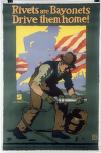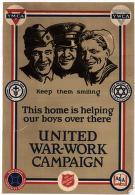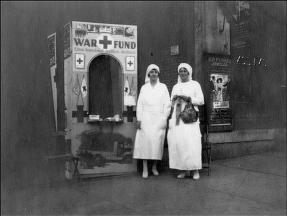|

"Rivets are Bayonets / Drive them home!

"Keep them smiling"- WWI broadside

"Allies, Arise!"

Red Cross Volunteers

"More Power to the Allies"

"Farmers Help the Belgians"
|
Summary and Objective
Students will understand that America faced various obstacles, both domestic and foreign between 1914 and 1917 as World War I was underway in Europe, and how the United States overcame these obstacles. Students will use articles and images to analyze the situation facing President Wilson and the way he used propaganda to overcome the obstacles. They will determine the overall effects of propaganda on the nation during WWI.
Teaching Plan
Step 1.
The teacher and students will be using one document located on the South Hadley High School Library (South Hadley, Mass.) Web site (see link below), wwi-newsletter-in-America.pdf (document a.) Before beginning the lesson, the teacher should review the situation in Europe and in the Atlantic Ocean prior to 1917. The teacher and students will then read and examine the “Year in Review” newsletter (Doc. a). Students should pay careful attention to the details contained within the letter to extract the information essential to understand the obstacles facing the nation. Students should be able to complete the questions: 1. Why did America enter World War I, according to President Wilson? 2. What obstacles did America face when it entered World War I in 1917? 3. How did President Wilson overcome the stated obstacles and mobilize America for war? *The teacher should also make sure that the students understand the concept and definition of Propaganda before moving to Step 2.
Step 2.
After determining the obstacles that America faced and the way in which President Wilson will overcome these obstacles with propaganda, the teacher should review these three questions that the students will answer for EACH piece of propaganda. Prior to answering the 3 questions, the teacher should model the way in which students should analyze the propaganda using the “I Want You” piece of propaganda from the Newsletter (Doc. a). The teacher should model which types of responses he/she would like from propaganda questions. Questions for Propaganda: 1. For whom was this piece of propaganda designed? 2. What was this piece of propaganda trying to get people to think? To do? 3. What propaganda techniques did this piece of propaganda use to be effective? Explain.
Step 3.
Students will complete the Questions for Propaganda following the directions, and by choosing 3 pieces of propaganda from the American Centuries Web site and the linked Web sites, “The Colored Man is No Slacker” (see link below), and “Over There” (see link below). The teacher should determine the number of pieces of propaganda that the students analyze, depending on time.
Step 4.
Once the students complete the Questions for Propaganda, the teacher should wrap up the analysis by stating that Propaganda in the United States achieved its goal by overcoming the stated obstacles from earlier in the lesson: (a) 4.2 million soldiers joined the U.S. military, up from 200,000 in 1917, (b) The War Bond Drive raised $33 billion in 2 years, (c) America is ready to send its first military force to France in June, 1917.
Step 5.
Teacher reminds students that propaganda did not end with the American entrance into war. Teacher will direct students to view one last piece of propaganda as evidence of the more negative effects of propaganda, “Spies and Lies,” (see link below). Have students analyze the image of “Spies and Lies” and have the students answer the question, ‘What is going on in this photo?’ The students’ responses will exemplify part of the purpose of this propaganda piece, i.e. to show that it is not clear exactly what is going on; spies could be anywhere. Then read the caption as a class and answer the 3 Questions for Propaganda. Teacher should tell students about the Sedition Act (1918) that fined or jailed American citizens who made disloyal remarks about the government or military.
Step 6.
To wrap up the lesson, the teacher will direct a discussion about the effects of government-sponsored propaganda. Teacher will lead the students with 3 questions: 1-Is government sponsored-propaganda during war-time a good thing? Why or why not? 2- When propaganda messages come into conflict with 1st Amendment guarantees to free speech, which should prevail? 3-Can government-sponsored propaganda be carried too far? Why or why not?
Step 7.
Post Activity: Have students think about the examples of government-sponsored propaganda today and have the students think about the messages and techniques that are used today to convince people to follow the given message in the propaganda (for example, an ARMY or NAVY commercial on television).
|




